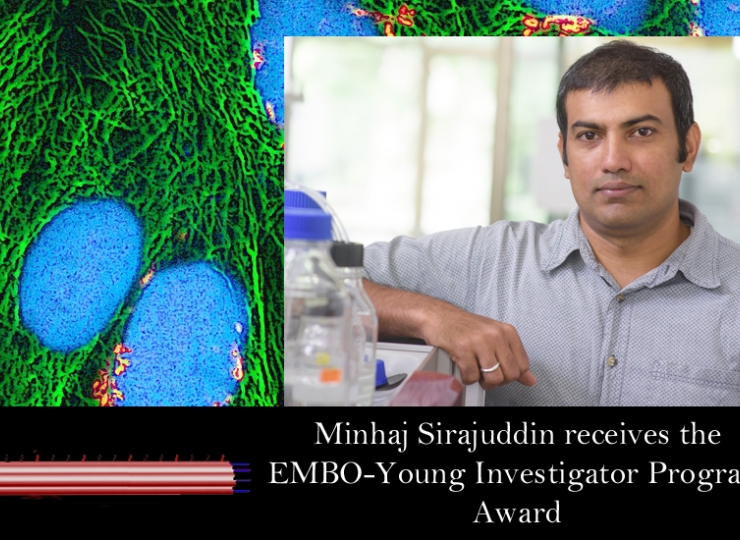Praveen Vemula heads the laboratory of self-assembled biomaterials at inStem. His group’s work falls into the realm of translation research, where the fine line between basic and applied research is often crossed and re-crossed to bring the two fields together. Vemula and his team explore ways to harness the potential of nanotechnology and biomaterials to address unfulfilled requirements for biomedical needs.
Could you tell us a little about your work? What about your work excites you?
We work on self-assembling nanomaterials to create biomaterials that can be used in a variety of therapeutic purposes. At present my team is developing novel biomaterials and concepts to enhance the lifetime of transplanted organs and mitigate gastric immune disorders such as Inflammatory Bowel Disease (IBD) and Ulcerative Colitis (UC). Work in our group proceeds in two very different ways – the first is a very basic materials approach, what I call ‘technology push’, while the second is a translational research approach, or ‘clinical pull’. These two approaches converge into an amalgam to make a large impact. Our basic materials approach is predominantly curiosity-driven, and we try to tinker with properties of substances to develop arrays of new materials. These materials may or may not have the required properties to solve existing problems, but are there for future reference – this form of research is technology driven, allowing us to understand the structure–function relationship of materials and is purely for the sake of building a technological arsenal. An apt analogy is somewhat like making lots of gloves, then finding the right hands to fit them.
Our second approach, based on translational research is personally much more exciting for me. It somehow satisfies my urge to apply whatever research I do to solve a problem. In this method of enquiry, we interact with clinicians to understand existing problems and have a targeted approach to designing a new material. We conceptualise and customise our inventions to tailor a unique solution to a given problem. This is actually using technological knowledge to create a remedy.
Over the span of your research career, I’m sure lots of people have asked you about your work. What questions do you find most unsettling, and how do you answer them?
Over the course of my journey in academia, I have seen how people tend to approach problem solving, and many times, I hear differing opinions and interpretations about the value of basic research versus applied research. One of the scariest questions I have heard, come from my peers across the world – Why do you need more data on drug delivery? There is plenty, in fact, there is tons of empirical data available, so why not just use that instead of trying to accumulate more?
I try to deal with these interlinked questions by pointing out to people that all empirical data about drug delivery generally have case-specificity problems. No two studies can be exactly alike, so it becomes very difficult to separate a phenomenon from background noise or chance effects even though data sets can appear to be large. I also elaborate the fact that a lot of good solutions to problems come about by the application of knowledge culled from ‘basic research’. Applied research is useful only when you have the pre-existing technology to solve a target problem. This is rather like knowing what path to take, but the prerequisite to get there can be provided only by basic research
Therefore, I believe there needs to be a balance of both approaches while doing science. We need basic research, where you delve deep into and try to understand a small part of the world in its entirety. We also need the problem-solving approach of applied research which uses such information to make lives better.
While dealing with non-scientists, I am slightly better prepared because I understand that they are looking for deliverables. “What use is your research? What are you trying to cure?” In fact, these are two questions I ask myself very often to keep my focus in check! While tough, these questions are quite answerable if we can just make a link between our science and other peoples’ everyday lives. I find these interactions very useful and important as they make me think about how I need to articulate science to the public. These questions also help me to get my team to take a larger view of our work – to think about the larger implications of a particular line of research and not just become stuck in the loop of “what’s the next experiment?”
Speaking of communication and outreach, how do you try to communicate your science to the lay public?
Communication and outreach are topics that interest me deeply. My friends Dr. Venkata Krishna Rao Jala (Univ. of Louisville), Dr. Syamprasad Nukavarapu (Univ. of Connecticut), Dr. Gauthami Jalagadugula (Temple Univ.) and I used to listen to the online-radio station ‘Telugu Tharanga’ while working in our labs and were impressed by its wide-reach. This spurred us on to contribute to spreading awareness about science through this medium, and we began to do science shows on this radio station. Every fortnight we conducted a 2-hour live show called “Science Kaburlu” for people from non-scientific backgrounds either about exciting new developments in sciences, or about general research discoveries, like vaccination. Although every child gets vaccinations, few actually know how this provides protection. A lot of our episodes were on general topics just to educate the public about science.
So, what was your target audience for these shows? What are other outreach activities do you enjoy doing?
These shows were done in Telugu, but have had a worldwide audience. On our live-show, we used to get calls from people in the US, Australia, Europe and even Middle Eastern countries. They were from all walks of life, from housewives to bankers to software engineers and we were quite surprised by the quality of questions they asked and their enthusiasm to learn more. Although our radio shows have been suspended lately, we are trying to restart them now. We hope to branch out into more languages, specifically English, for the next round of sessions.
Apart from these radio shows, I also regularly visit schools and undergraduate colleges to spend time with and talk to students about research as a career. I find that most students in Indian schools view higher education as either obtaining a degree in engineering or in medicine, mainly because they keep hearing about them – it is a daily presence to the majority of the population. We need to change that, and popularise science through outreach and communication. People need to know what research can do, and even if I can get one person in a class or 10% of my audience interested, it can go a long way.
What drew you towards your particular field of research?
It was a journey that began just after I obtained my Master’s degree. I was a blank slate. I heard about research for the first time from my father in the early nineties when he explained to me that scientists do research and develop technologies like the Agni missile. I did not know what research actually was and plunged into a PhD with the idea that I could invent something useful through research in a laboratory.
I come from an organic chemistry background, and till I completed my PhD, I was of the opinion that basic research is only carried out in a lab. We could invent things, yes, but during the PhD phase, that’s where the possibilities of research ended for me. My experiences during my post-doc were real eye-openers. That was where I realised that the drugs we take are a prime example of translational research – research that crossed the boundary of the laboratory and made its way into the realm of industry.
I realised that people in research, people like me, could take their science out of the academic atmosphere and actually apply their work in a ‘real-world’ setting. This is why I want to tell students that the medicines you take or the mobile you use comes from this marriage between research and practical use. Many of my MSc classmates are lecturers in colleges and I go to these places to interact with students. It is very exciting to see how they get worked-up with newfound enthusiasm once they understand the importance of research in product development.
What factors do you think might play a critical role in translational research?
I am a big advocate of science-entrepreneurship. I believe that every researcher – even at a graduate level – should be exposed to the principles of entrepreneurship. This is particularly helpful in clinical translational research, as it allows people to think about identifying possible problems to address. This, in turn, will help researchers and clinicians to set up benchmarks for the development of technologies to make an impact in the quality of patients’ lives.
For example, if I am aware of what could be a potential translational and/or regulatory hurdle in say, about 10 years’ time in the field of therapeutic development, I could think about it now and make a course-change to eliminate that risk. In addition, it will encourage one to have due diligence in cultivating novel intellectual leaps. In a nutshell, thinking ahead in terms of entrepreneurship forces unconventional forms of reasoning that could lead to developing simple solutions for complex problems.
In the field of translation research, can you tell us about an idea-to-remedy story that you have been involved in?
Fortunately yes! During my postdoctoral research at Harvard, I was part of a team that developed a product that can prevent metal-induced skin allergies. This kind of allergy, called contact dermatitis, is caused when we are exposed to tiny amounts of metal ions that are often released from accessories, gadgets, or jewellery. However, sometimes these tiny amounts of metals cross a ‘tolerance threshold’ and can evoke severe allergic reaction. Several million people around the world suffer from such allergies. Until last year, there were no preventive products available to prevent metal-induced skin allergy.
At Harvard, we developed a dermal nanoparticle cream that acts as a barrier on the skin to capture metal ions and prevent their penetration into the skin, thus preventing metal-induced skin allergy. Based on this discovery (which we have patented), a Paris/Boston based start-up company named ‘Skintifique’ was formed. . After completing a pilot study on clinical efficacy, we have now launched these products on an international scale.
I continue to be associated with the company as a scientific advisory board member and chief consultant. Our team often has brainstorming sessions to formulate novel strategies to develop new lines of products. Thus, being part of a translation process where an idea actually did become a therapeutic product inspires me every single day. It continues to fuel an internal fire to develop many more such technologies to solve unmet clinical needs.
Do you see a change in how scientific research is perceived in India since your time as a student?
Yes, I do see the change. People are much more aware of basic and applied science and are consciously working on improving things for research. The IISERs (Indian Institutes of Science Education and Research) and the KVPY programme are fantastic! Their focus on exposing undergraduates to research is going to go a long way in igniting youngsters’ passion for science. The updated curricula in the IISERs are also very important advances.
However, the field of bioengineering is still at a nascent stage here. At least to my knowledge, there are hardly any adequate examples of lab-to-clinic success stories from India. So, there is an incredible opportunity for people in this field to set those examples. I feel that even a few stories like these are going to set the stage for immense growth in clinical translational research in India.
On the other hand, I also see that there is a general lack of organised mentorship for post-doctoral fellows in India. Our post-docs are an absolutely critical population as they are the pool from which the next generation of research leaders are going to emerge. They are in a unique position of being mentors to young research scholars, while still being mentored by a principal investigator. At this stage, post-doc researchers need to change their mind-set from “what’s my next paper?” to taking responsibility for their ideas and thinking of initiating long-term projects.
Post-docs also need training in skills like management (of students, grants, and collaborators) and communication for grant-writing. Generally, individual mentors take initiatives to impart such knowledge, but this is very heterogenous and we need broad programmes to equip our post-docs for the next step in their careers. The Post-Doctoral Fellow’s Association had organised a symposium to this effect, and I believe it’s a very good start.
While on the subject of post-doctoral research and long-term research projects, what are your views on the ownership of ideas? Many investigators who run labs have invested much thought and many years of hard work in developing ideas, and are often upset when outgoing students or post-docs take these ideas to other research groups. What do you think?
It does not bother me. I believe that everybody should have intellectual freedom – they should not be stopped from disseminating ideas. However, I think they ought to be ethical in how they use this freedom by giving due credit to their senior investigators and the institutes which contributed to the idea’s growth. Here is where good communication between the lead investigator and the younger researcher is very important. Instead of assuming or imagining a negative response, a quick and candid chat can establish boundaries and even lead your thinking in exciting new directions. Most PIs have atleast a few years’ headstart in thinking about the problem you want to tackle, so they can be quite helpful in sketching out future directions. Also, such interactions invariably lead to collaborations, and who wouldn not want that expansion to their network?











